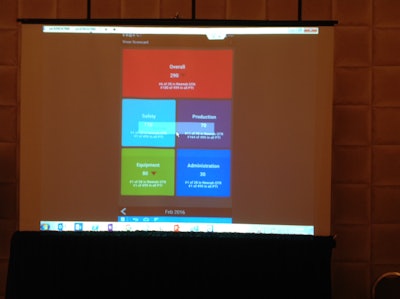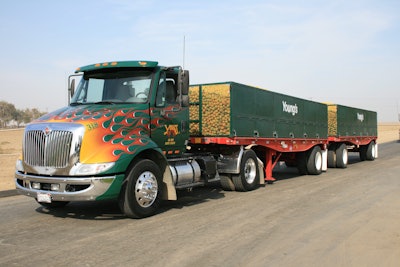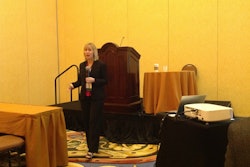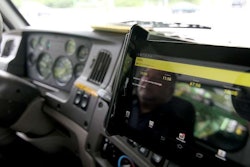 Peter Covach, IT systems analyst for Paper Transport, speaks during the Omnitracs user conference, Feb. 1, 2016, in Dallas.
Peter Covach, IT systems analyst for Paper Transport, speaks during the Omnitracs user conference, Feb. 1, 2016, in Dallas.About six years ago, Paper Transport reconfigured its telematics platform to automate the workflow for drivers for arrival and departure events. It later purchased tablets and a mobile app to further expand driver connectivity.
During the past year management has opted to replace both of these systems in favor of developing a custom mobility platform to offer drivers an even better work experience, says Peter Covach, IT systems analyst.
“We try to be as much of a driver-focused company as possible,” he says, and notes that the Green Bay, Wis.-based dry van carrier has a turnover rate of approximately 35 percent with a fleet of 570 trucks.
Ultimately, Paper Transport chose the XRS mobile platform from Omnitracs, he says, because it runs on the kinds of mobile devices and operating systems that drivers are already familiar with.
“We wanted something that was first easy for the driver, and something that we could scale out,” he says.
The company customized the XRS mobile platform to integrate with its back-office systems and the company’s own Android mobile app, which it developed internally.
The proprietary Android app includes a driver scorecard that gives drivers a daily snapshot of their overall score, and individual scores in the four categories of safety, production, equipment and administration.
One of the safety metrics is derived from sudden deceleration or “harsh braking” events. The XRS system captures a detailed record of vehicle speed, location, and driver inputs starting at 90 seconds before the event and 30 seconds after.
By the next morning from the day the critical safety event took place, drivers see an updated score and can drill-down into the details of what happened and where.
 Paper Transport developed a mobile app with a driver scorecard that has four reward categories.
Paper Transport developed a mobile app with a driver scorecard that has four reward categories.“Our scorecard used to be very high level and didn’t have detail. Drivers would only get a score 30 days later,” he says. “With the new iteration, we are able to download, validate and display that data to drivers in a timely manner.”
And what a difference it has made. “Now drivers actually believe what is coming out of scores. It has really been driving our driver behavior, which is fantastic,” he says.
Driver gamification
For Paper Transport, one of the benefits of developing a custom mobile platform is having a single sign-on experience for drivers, Covach says. When a driver signs onto the company’s Android app, his or her ID is automatically pushed out to other cloud-based apps, like XRS for electronic logs, its driver scorecard, and an app it uses to deliver online training.
Fleets don’t have to develop their own mobility platform to provide feedback to drivers, however. A number of third party software applications and services offer driver scoring and gamification programs for minimal investment.
Some collect data by connecting directly to the vehicle’s databus and others can use data from any source.
PedalCoach uses a mobile app and connectivity device to give drivers a score for fuel performance that is independent of factors they cannot control such as equipment type, load weight, topography and other operating conditions.
Vnomics TrueFuel gives an overall fuel efficiency score and instant feedback — a distinctive beep — when drivers exceed the RPM threshold for optimal fuel economy, which for most vehicles is 1,500, says Mari McGowan, director of market development.
At the end of each trip — an ignition on/off event — both PedalCoach and the TrueFuel show drivers a fuel efficiency score based on a scale of 100. Additional details like the gallons a driver wasted over a certain time period or how much time they spent in each gear are available for review through a fleet management web portal.
Young’s Commercial Transfer, a dedicated trucking company serving western agribusiness, uses data from the Vnomics system to automate its driver incentive program.
 Young’s Commercial Transfer uses a “shift” score from Vnomics to automate a driver bonus program.
Young’s Commercial Transfer uses a “shift” score from Vnomics to automate a driver bonus program.During the harvest season, its drivers can earn a bonus of 20 percent of their gross earnings by keeping their weekly “shift” scores at a 97 or above. The company uses Eaton 10-speed manual transmissions.
By hitting the maximum 20 percent bonus, drivers receive between $4,000 and $5,000 during a 120-day period in which they work 12 hours a day, seven days a week.
“It’s a well-earned bonus,” says Jeremy Patterson, manager of the Porterville, Calif.-based fleet.
The in-cab unit gives drivers their shift scores daily and the company posts driver scores weekly at all terminal locations. On average, the 400 drivers in the fleet have a shift score of 94 percent.
“When we focus on one thing, achieving a great shift score, everything gets better,” he says. “We reduce wear and tear on equipment, save fuel and create safer drivers.”
Drivers that maintain a shift score of 100 percent for four consecutive weeks also receive special hats and t-shirts.
Automating non-cash rewards
Stay Metrics says that carriers can use metrics from virtually any type of telematics or driver management system to engage drivers with its online rewards and recognition platform. Once carriers set up a custom rewards program, Stay Metrics clients are able to automatically award points to drivers for achievements.
Carriers typically send a file of comma-delimited data, organized by driver code and reward categories. Most database systems can quickly produce such reports and send them using file transfer protocol (FTP).
The rewards platform sends email notifications to drivers when points are awarded, prompting them to login regularly and monitor their progress. Drivers can redeem their points towards a selection of more than 40,000 items in an online catalog.
With so much information that is available on driver performance, automated scorecards and gamification programs have made it easy to reward and recognize drivers for positive contributions.













